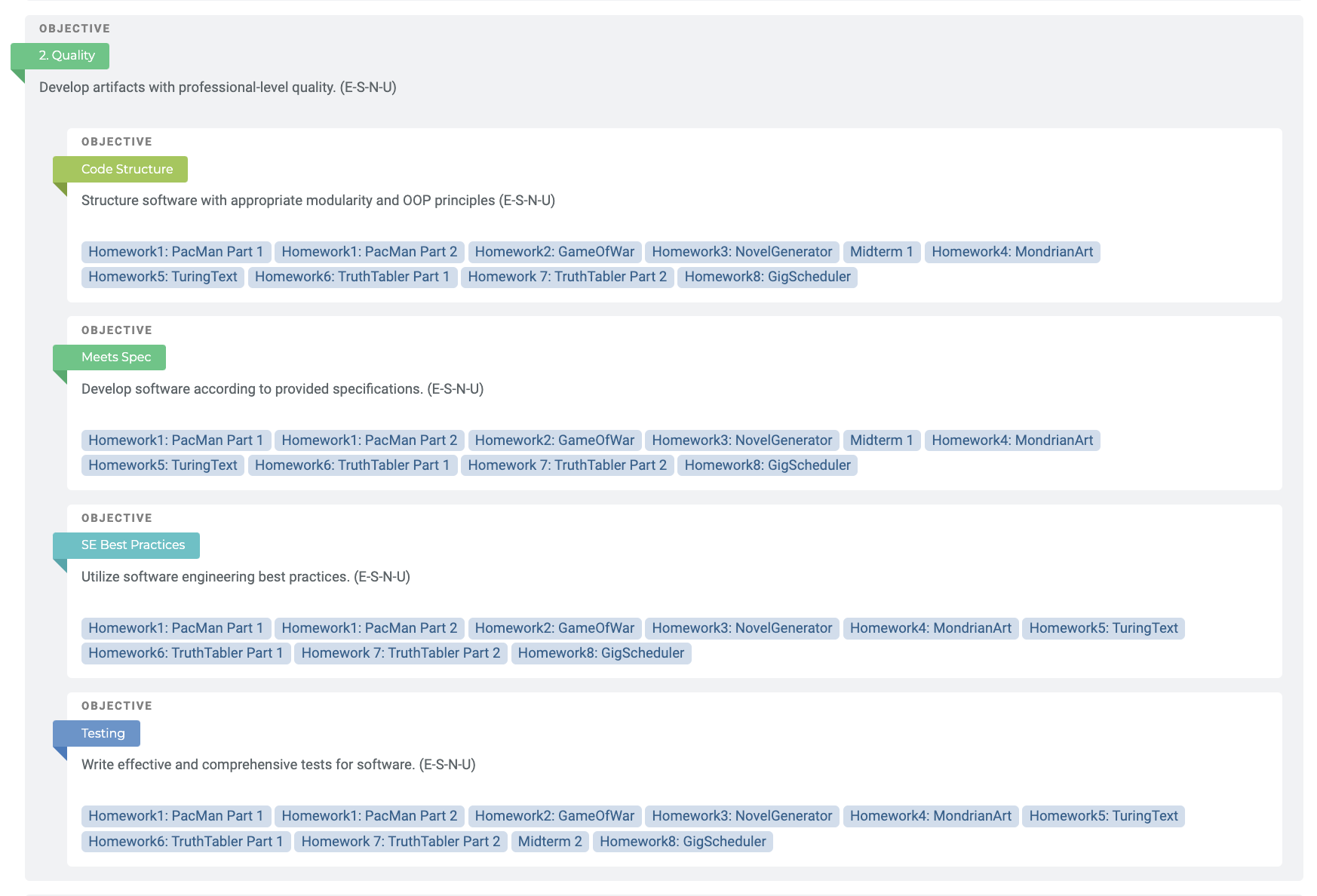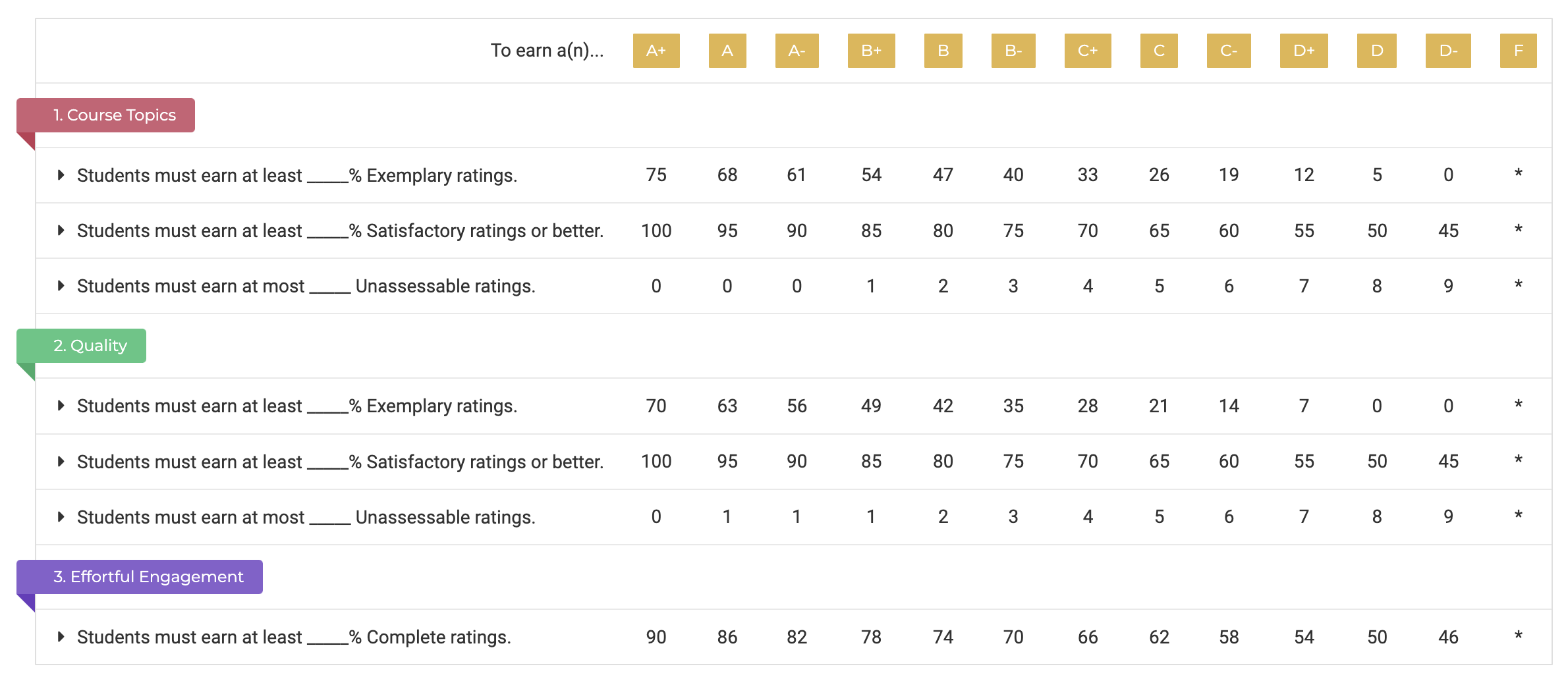Sample Syllabus Language
We know it can be difficult to communicate to students how mastery grading works, especially to students who are used to traditional grading. In the following sections, we'll share the language that we use in our syllabi. Feel free to copy and modify however you like. It's always easier to edit than to author from scratch!
Note that much of the syllabus language is specific to this course and its requirements. We're not claiming that this is the optimal way to run a mastery grading course; we just want you to see one way to run a mastery grading course.
Okay, on to the syllabus!
Sample Syllabus
[YOUR COURSE NAME & DETAILS HERE]
[YOUR INSTRUCTOR NAME AND DETAILS HERE]
Prerequisites
[YOUR PREREQUISITES HERE]
Course Objectives
The objectives for this course define the knowledge and skill goals expected of students by the end of the course. Assignments that relate to each objective are included in the objective definition.
[YOUR COURSE OBJECTIVES WITH ASSOCIATED ASSIGNMENTS HERE. We'll omit our full list of objectives for brevity, but below is a screenshot of how we present the Quality objective.]

Course Texts
[YOUR REQUIRED TEXTBOOKS HERE]
Grade Breakdown:
Grading in this course is a variation of a "Mastery Grading" system. The premise of this grading system is that your final letter grade (your "grade distinction") reflects the level to which you have achieved mastery of the course learning objectives by the end of the semester. Individual assignment "grades" in a Mastery Grading context look less like numbers (e.g., "98.64%") and more like descriptive words associated with a single course objective: (e.g., the words "Exemplary," "Satisfactory," and "Effortful" are all "grades" you may receive in this course).
Rather than the term "grades," which evokes the nonsensical tradition of translating student work into arbitrary numbers on a 100-point scale, we prefer to use the term "assessment" to represent an assignment, exam, etc. that has been reviewed by an instructor and the term "rating" to represent the a specific level of mastery that a student's work evidences for a specific objective. For example, an assessment might contain three ratings: a Satisfactory rating in Data Structures, an Exemplary rating in Algorithms, and a Not Yet rating in Testing. No overall rating will be provided for an assessment.
Assignments & Exams:
Information regarding assignment/exam dates and submission instructions will be provided on a per assignment/exam basis. The tentative schedule for assignment due dates and exams can be viewed on the course calendar (Appendix III).
Each homework assignment and exam in this course will map to some number of course objectives. Homework assignments will map to 5-7 course objectives, four of which will remain constant throughout the semester (the four "Quality" objectives: "Code Structure," "Meets Spec," "SE Best Practices," and "Testing"). The remaining 1-3 objectives will relate to the course content the assignment is intended to assess. Similarly, exams will map to 5-7 course objectives, though not all Quality objectives will be included. The mapping of homework assignments to objectives can be seen in the list of objectives below, as well in each assignment description.
Student mastery in each of the objectives per assignment/exam will be assessed with two rubrics, seen in Appendix I below.
After submitting each assignment/exam the first time, most students' work will be rated at the “Satisfactory” level of mastery for many of the objectives on any given assignment —- and that is fantastic! Few students' work will achieve an “Exemplary” level of mastery on all of the objectives on their first attempt.
For this reason, and because this course focuses on student growth, each assessment includes actionable feedback with the goal of improving mastery upon resubmission of the work. Homework assignments may be resubmitted for reassessment an unlimited number of times in the 28 days following the original assignment due date. Exams may be retaken twice, once at the time of the next exam (you will sit for both exams at once), and once during the final exam period. There is no penalty for resubmitting an assignment or exam question. Specific instructions for resubmissions will be provided in a separate document.
In keeping with our classroom value of "Effortful Engagement", students cannot generally resubmit their work to improve from an “Unassessable.” In simpler terms, students cannot rely on the resubmissions to procrastinate. Students cannot request reassessment of work that they didn't do before the deadline. However, we understand that sometimes things happen that are out of your control, so, on exactly one resubmission, a student may request reassessment of any number of “Unassessables” with the intent to achieve a higher level.
Effortful Engagement (Labs, Readings, Polling):
Lab Exercises: A portion of class time will be spent actively completing problems in the classroom. If these problems are not completed in class, students are responsible for completing them outside of class and bringing them to the next class meeting (unless other instructions are given). These labs will be primarily assessed for completeness, but for quality purposes, a lab may be loosely assessed for correctness without advance notice. Because the majority of work required to complete labs is intended to be completed in class, feedback will be provided in class regarding the correctness, strategies for improvement, etc. If additional feedback on these assignments is desired, please visit the instructor or TAs during office hours.
Reading Assignments: Prior to each class meeting, students are responsible for reading the assigned content and completing the textbook exercises. These exercises can be completed online and should be finished prior to class time. However, the exercises are formally "due" on the friday night following the class for which they were assigned.
Polling: Each day of class, the instructor will pose multiple-choice, short answer, and other participation questions using TeachFront. Students are responsible for responding to each posed question on TeachFront.com via their smartphone or tablet (laptops should only be used as a last resort, as they're quite distracting to neighbors). An assessment of "Complete" will be given to students who answer least 75% of class activities for the given day. Assessment is for participation only. Polling activities will not be assessed for correctness if respectful effort is exhibited.
Each lab/reading/polling assignment will be assessed using the Effortful Engagement scale, seen in Appendix I below.
Because lab, reading, and class polling assignments are evidence of conscientiousness (and thus evidence of skills that students already possess), students may not resubmit these items.
Note: We expect that events will arise that are out of a student's control and might prevent them from attending class or from completing a reading/lab on time. For this reason, about five "freebies" are built into the Effortful Engagement threshold. (Notice that the A+ grade in the table below only requires 95% Complete labs, readings, and polls. There are over 100 possible assessments in that category, so missing about 5 of these will not negatively impact a student's grade.) For this reason, students should not panic if they forget to submit a lab or if they accidentally sleep through class one day. We're all human.
End-of-Semester Grade Distinctions:
End-of-semester grade distinctions in this course are based on a student's portfolio of work. This (metaphorical) portfolio includes the student's best work for every assessment opportunity throughout the semester (homework, exams, labs, readings, etc.), as well as the student's best ratings for that work. Those ratings will be counted per mastery level (e.g. the number of ratings at the Exemplary level, at the Satisfactory level, etc.) and those counts will be used to determine a grade distinction using what we call "grade distinction recipes".
A "grade distinction recipe" is a description of what a portfolio must look like to earn a certain grade distinction. Every grade distinction has its own recipe. The recipe for each grade distinction will stipulate that a portfolio must have at least some number of Exemplary ratings, at least some number of Satisfactory ratings, etc. A student will earn the highest grade distinction that their portfolio can satisfy. Students' portfolios must satisfy every requirement of a given grade distinction's recipe in order to earn that grade distinction. For a more thorough description of how grade distinction recipes work, read the article linked here. The grade recipes for this course are outlined in Appendix II below.
Each grade distinction has its own recipe. description of set of thresholds that define a specific distribution of mastery level that can earn a specific grade distinction. The ingredients of a grade distinction recipe are varying tally thresholds of the four levels of assessment from homework and exams (E-S-N-U: Exemplary Satisfactory, Not Yet, and Unassessable) and the two levels of assessment for labs, reading, and polling (Effortful Engagement: Complete and Incomplete).
The instructor reserves the right to modify the grade recipes at any time, with or without prior notice to students. However, changes will be limited to those with potential to increase student grade distinctions.
Course Policies
[YOUR COURSE POLICIES HERE]
Appendix I: Mastery Level Schemes
[YOUR MASTERY LEVELS HERE. Below is a screenshot of how we present our mastery level schemes.]

Appendix II: Grade Calculations Table
This table defines the set of recipes used to calculate grade distinctions in this course. A student's portfolio of work must meet every requirement of the recipe for a grade distinction in order to earn that grade distinction.

Appendix III: Course Calendar
[YOUR COURSE CALENDAR HERE]
Looking Forward
There you have it. With your syllabus written, you'll have the last administrative step complete! We're glad you're still with us on this tutorial journey. Mastery grading makes such a difference in students' learning!
The next series of articles explain how to design assignments that are well-suited to mastery grading and how to assess student submissions for mastery. Off we go!